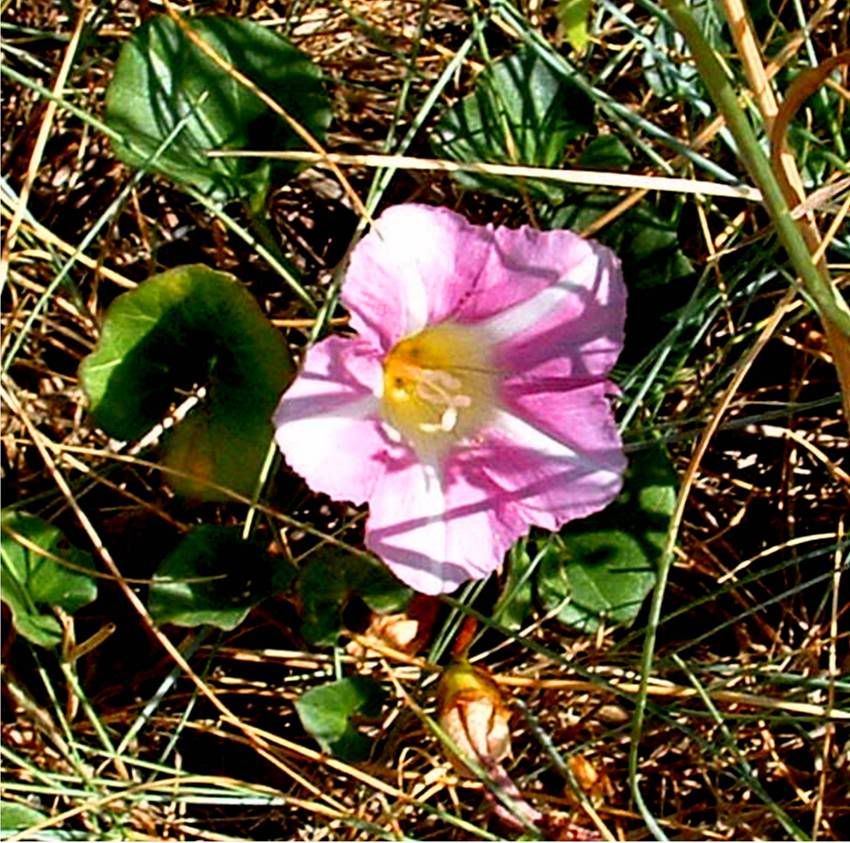South is the Humber Estuary, a slow brown ooze; East, the cold grey blue of the North Sea. Where these meet, a long crooked finger of almost-land juts out into the tide, an ever-changing desolation of sand and shingle and mud. Each winter brings a realignment, a chance to breaking away from the mainland, and is followed by the need to rebuild the road that straggles to the end of this impudent finger.
 The road itself is a patchwork of concrete slabs, some inlaid with old railway lines, and odd strips of interlocking blocks which can be dug up and re-laid, at least where there is sufficient land to put them. A single track, with occasional passing places and lay-bys, it connects the isolated lifeboat station and coastguard to the rest of the world. To leave the road surface is to risk grounding, and becoming stuck in deep, soft sand. High banks, covered in bramble, leathery grey-green sea buckthorn and spiny marram grass both protect the roadway and threaten to engulf it. Convolvulus twines through the scrub, turning striped trumpet flowers towards today’s blue sky. It’s not always so welcoming.
The road itself is a patchwork of concrete slabs, some inlaid with old railway lines, and odd strips of interlocking blocks which can be dug up and re-laid, at least where there is sufficient land to put them. A single track, with occasional passing places and lay-bys, it connects the isolated lifeboat station and coastguard to the rest of the world. To leave the road surface is to risk grounding, and becoming stuck in deep, soft sand. High banks, covered in bramble, leathery grey-green sea buckthorn and spiny marram grass both protect the roadway and threaten to engulf it. Convolvulus twines through the scrub, turning striped trumpet flowers towards today’s blue sky. It’s not always so welcoming. There are gaps, views of the estuary. Wide mudflats shimmer with mirages in the heat, dotted with distant birds wavering in the haze. Oystercatchers probe the mud deeply with carrot-coloured beaks, triumphantly hauling out ragworms, a lone grey plover potters about mournfully, poking a shorter beak into the semi-liquid ooze for small crustaceans and shellfish. No wonder it looks miserable.
There are gaps, views of the estuary. Wide mudflats shimmer with mirages in the heat, dotted with distant birds wavering in the haze. Oystercatchers probe the mud deeply with carrot-coloured beaks, triumphantly hauling out ragworms, a lone grey plover potters about mournfully, poking a shorter beak into the semi-liquid ooze for small crustaceans and shellfish. No wonder it looks miserable. Curlews, longest beaks of all, stalk the outer flats, searching the deepest mud. A distant line of black dots out on the water resolves itself through the binoculars into a flock of scoter, black seaducks gathered together to moult their spring feathers. Surprised by a seal, they take to the air in a flurry of dark wings, only to land with a barely controlled splash a few hundred metres away.
Curlews, longest beaks of all, stalk the outer flats, searching the deepest mud. A distant line of black dots out on the water resolves itself through the binoculars into a flock of scoter, black seaducks gathered together to moult their spring feathers. Surprised by a seal, they take to the air in a flurry of dark wings, only to land with a barely controlled splash a few hundred metres away.
On the seaward side lies the beach, lined with scattered concrete blocks – tank barriers – like children’s toys left out and weathered in a forgotten corner. A slick of muddy water spreads from the river mouth beyond sight of land. Container ships wait out beyond the channel for the tide to turn, bound for Hull and Grimsby, or up river to Goole. To reach there, they will pass under the span of the Humber Bridge, 25 years old today and only just visible on the horizon.
A slick of muddy water spreads from the river mouth beyond sight of land. Container ships wait out beyond the channel for the tide to turn, bound for Hull and Grimsby, or up river to Goole. To reach there, they will pass under the span of the Humber Bridge, 25 years old today and only just visible on the horizon.
At the end of the land lies the small community of Spurn – houses, for the lifeboat men permanently stationed here; the road is too risky to rely on its being passable during a storm when they might be needed. The old lighthouse and landward tower now are home only to pigeons.
Wending our way back along the track, we come across a patch of sea holly, crisp silver grey-green, flowers tinged with electric blue. A survivor, like Spurn itself.

2 comments:
I am so enjoying your portraits of your land. The place seems harsh and beautiful and dangerous and well worth it! Land by the sea is special. Like a lovely but self involved god. Enjoy it, love it, but don't expect it to give any quarter or nod to you.
Jude
This is so lovely Mad! The photos of the mud flats remind me of my teenage years spent on Mersea Island in the Blackwater Estuary...
Post a Comment